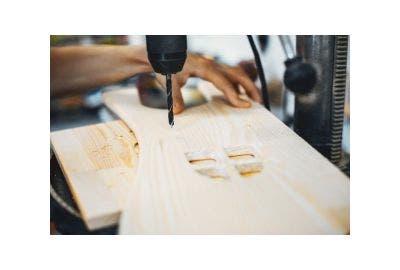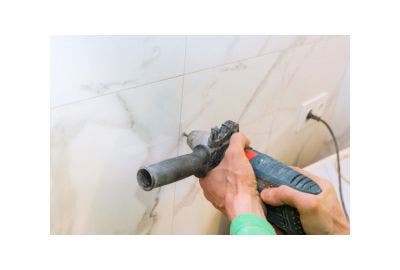Choosing the right drill bit is essential for achieving clean, precise holes and preventing damage to both the material and the tool. Different materials—masonry, wood, and metal—require specific drill bits designed to handle their unique properties. Using the wrong bit can lead to inefficiency, excessive wear, or even breakage.
Masonry drill bits are built to cut through tough surfaces like concrete and brick, while wood drill bits are designed for clean cuts in timber without splintering. Metal drill bits, on the other hand, feature sharp edges that slice through metal without overheating. Understanding these differences helps professionals and DIYers work efficiently and extend the lifespan of their tools.
This guide compares masonry, wood, and metal drill bits, highlighting their design, materials, and best practices. It also covers key differences to help you make an informed choice for each drilling task.
Drill Bits for Masonry

Masonry drill bits are specifically designed for drilling into hard materials like brick, concrete, and stone. These surfaces require a bit that can withstand high resistance while effectively channelling away dust and debris.
Material & Coating
Most masonry drill bits are made from tungsten carbide or have a carbide-tipped steel body, ensuring durability and resistance to wear. Some feature coatings that reduce friction and extend lifespan.
Design Features
Masonry bits typically have a chisel-like tip that helps break through tough surfaces. Their spiral flutes are designed to remove dust efficiently, preventing clogging and overheating. These bits are often used with hammer drills, which provide a pounding action to aid penetration.
Best Practices
- Use a hammer drill for masonry drilling whenever possible, as the pounding action significantly improves efficiency when drilling into brick, concrete, or stone.
- Apply steady, moderate pressure—too much force can cause overheating, while too little may reduce penetration effectiveness.
- Periodically remove the bit from the hole to clear out dust and debris, preventing clogging and overheating.
- Keep masonry bits sharp—dull edges reduce performance and require more effort to drill. If the tip shows signs of wear, consider sharpening or replacing the bit.
- Avoid using masonry bits on wood or metal, as they are not designed for clean cuts in softer materials.
Drill Bits for Wood

Wood drill bits are designed to create clean, precise holes in materials like softwood, hardwood, plywood, and MDF. Unlike masonry or metal bits, they focus on minimising splintering and ensuring smooth entry and exit points.
Material & Coating
Most wood drill bits are made from high-speed steel (HSS) or carbon steel, providing sharp cutting edges suited for different wood types. Some feature coatings like titanium nitride (TiN) or black oxide for heat resistance and durability.
Design Features
Wood bits commonly have a brad point tip, which centres the bit and prevents it from wandering before drilling begins. Their deep flutes allow for efficient chip removal, reducing friction and preventing overheating. Specialised bits, such as spade bits and auger bits, cater to different drilling needs—spade bits for large-diameter holes and auger bits for deep, clean cuts.
Best Practices
- Match the drill bit type to the job—use brad point bits for precision, spade bits for large holes, and auger bits for deep, clean cuts.
- Drill at a lower speed for hardwood to prevent burning. Softwood can be drilled at higher speeds, but excessive force should be avoided.
- Let the drill bit do the work—applying too much pressure can cause the wood to splinter or the bit to bind.
- Keep the bit sharp to ensure cleaner cuts and minimal splintering. If the bit starts producing rough holes, sharpening or replacing it may be necessary.
- Avoid forcing the drill—pressing too hard can lead to overheating and imprecise cuts.
Drill Bits for Metal

Metal drill bits are designed to cut through materials like steel, aluminium, copper, and brass. These bits need to be extremely sharp and heat-resistant to maintain performance when drilling into hard surfaces.
Material & Coating
Metal drill bits are usually made from high-speed steel (HSS), cobalt alloy, or carbide. Cobalt drill bits contain 5–8% cobalt mixed into the steel, not just as a coating, making them highly heat-resistant and ideal for drilling tougher metals like stainless steel. Carbide bits, which are even harder, are typically used for industrial applications due to their durability when cutting through very hard metals.
Design Features
A key feature of metal drill bits is their split-point tip, which helps prevent wandering and allows for precise drilling. Their cutting edges are sharper than those on masonry or wood bits, making them capable of slicing through metal without excessive pressure. Many also have a reduced shank to fit different drill types.
Best Practices
- Use cutting fluid or lubrication when drilling into harder metals to prevent overheating and reduce wear on the bit.
- Drill at a slow speed—the harder the metal, the slower the drill should run. Avoid using high speeds, as they generate excess heat that can dull the bit.
- Apply steady, controlled pressure without excessive force to prevent the bit from slipping or breaking.
- Select the right drill bit material for the metal type—HSS works for soft metals, cobalt bits handle tougher metals like stainless steel, and carbide is suited for industrial use.
Key Differences
Understanding the differences between masonry, wood, and metal drill bits ensures better results and prolongs tool life. The table below compares their material composition, tip design, drilling technique, best practices, and durability considerations.
| Feature | Masonry Drill Bits | Wood Drill Bits | Metal Drill Bits |
| Material | Tungsten carbide, carbide-tipped steel | High-speed steel (HSS), carbon steel | HSS, cobalt, carbide |
| Tip Design | Chisel-like tip for impact drilling | Brad point for precision | Split-point for accuracy |
| Drilling Speed | Medium speed with a hammer drill | Higher speed for softwood, slower for hardwood | Slow speed to avoid overheating |
| Best Practices | Use a hammer drill for hard materials, clear debris frequently | Match bit type to wood, drill at controlled speed | Use cutting fluid, slow RPM, apply steady pressure |
| Durability & Maintenance | Can wear quickly on very dense materials; sharpen or replace when tips dull | Risk of burning wood if used at high speeds; keep bits sharp | Overheats if used at high RPMs; use lubrication and sharpen when dull |
| Specialist Bits | Multi-construction drill bits work on various materials | Step drill bits allow for different hole sizes in one pass | Spot weld drill bits remove welds cleanly, tapping inserts create reinforced threads |
| Category | Drill Bit Type | Best For |
| Multi-Material | Multi-construction drill bits | Drilling through wood, masonry, plastic, and metal - HSS drill bits are popular for general DIY and professional woodworking tasks. |
| Large-Diameter | Core drill bits | Cutting large holes in masonry, concrete, and stone |
| Step drill bits | Drilling multiple hole sizes in sheet materials (metal, wood, plastic) | |
| Precision Drilling | Brad point bits | Creating clean, accurate holes in wood with minimal splintering |
| Spot weld drill bits | Removing spot welds in automotive and metalwork applications | |
| Countersink bits | Creating tapered holes to allow screw heads to sit flush | |
| Heavy-Duty | Hammer drill bits | Drilling into dense masonry and concrete with impact force |
| Auger bits | Deep, clean drilling in hardwoods and thick timber | |
| Cobalt drill bits | High-temperature resistance for stainless steel and hard metals | |
| Threading & Finishing | Tapping inserts | Creating reinforced, reusable threads in metal components |
| Reamer bits | Smoothing and enlarging holes in metal or plastic |
Choosing the right drill bit prevents damage to materials and extends the lifespan of both the bit and the drill.
Remember, the right drill bit for the job not only improves efficiency but also extends tool life and ensures cleaner results. Masonry, wood, and metal drill bits each have unique features suited to their respective materials—using the correct one prevents damage and enhances performance.
Understanding material composition, tip design, and best practices allows both professionals and DIYers to achieve precise results while keeping tools in good condition. Investing in high-quality drill bits for specific tasks saves time, effort, and money in the long run.
Explore Heamar’s range of drill bits to find reliable, durable options for every drilling need.




















